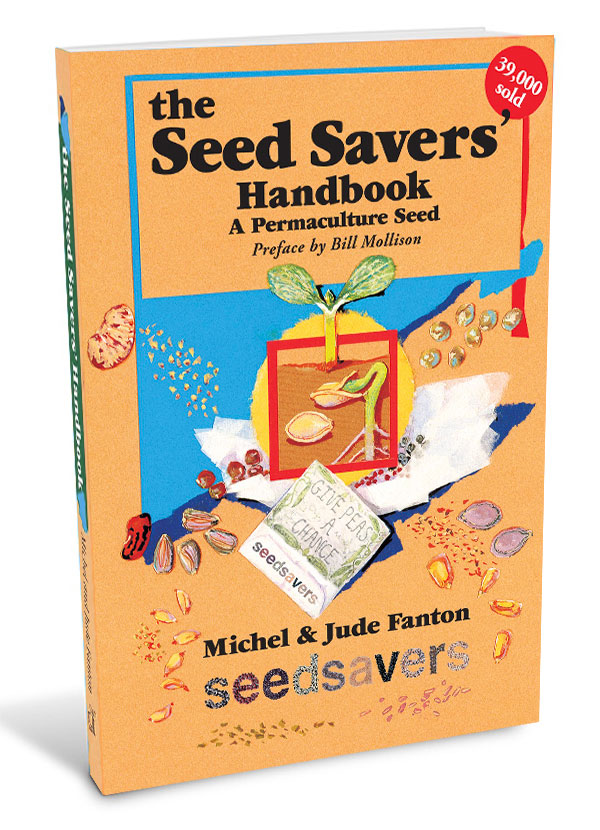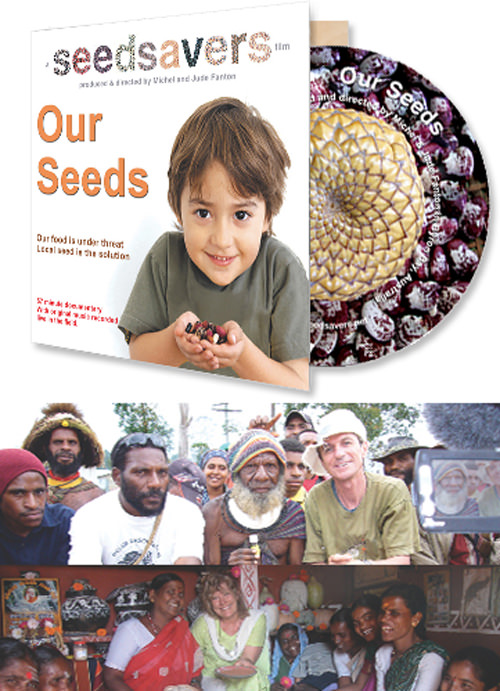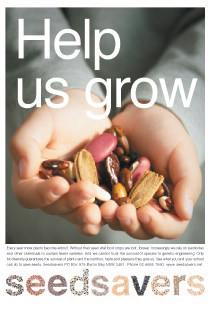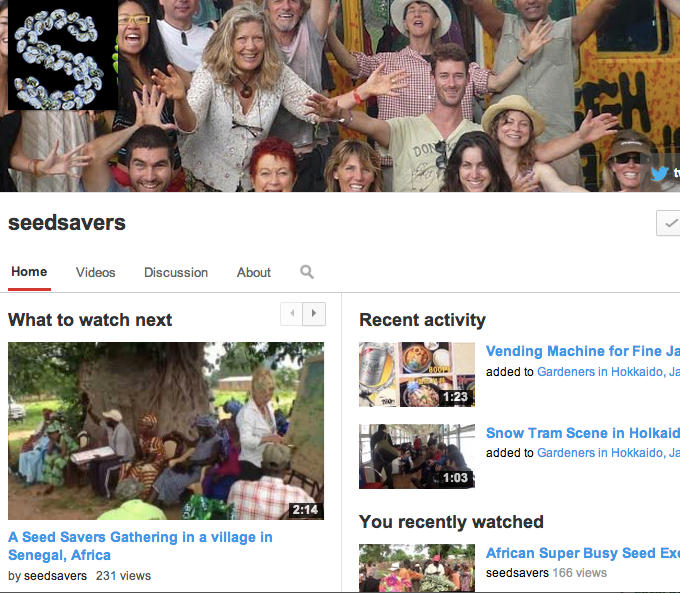In 1986 we established the Seed Savers’ Network, a registered charity in Australia.
Over 15,000 people have been directly involved with Seed Savers.
We continue to spread the seed saving message around the globe.
Here you will see the range of our achievements in Australia, where we are based.
See our work in other countries at Our Global Reach.
Major recent changes have been that from 2001 we decentralised the seed collection out to Local Seed Networks and from early 2008 we curtailed our hands-on administration, annual conference and production of a newsletter, supplanting it with appealing to a wider audience through film, a greater web presence and production of video clips.
As at early 2014 we had produced and uploaded over 1550 clips with in excess of 1.2 million views.
Seed Saving More Widespread
The Seed Savers’ Network has brought seed issues into the public realm where they are now regularly discussed.
Gardening journalists and authors now routinely include seed saving in their writings and in television gardening shows.
Australian gardeners have improved their seed saving skills through:
· Our publication, The Seed Savers’ Handbook, 33 000 copies sold at early 2014;
· Our seed saving workshops and courses;
· Local Seed Networks – now over a hundred around Australia;
· Visits to Seed Savers’ Gardens;
· Annual Seed Savers Conferences (1988 – 2008);
· Seed Savers’ newsletters (biannual from 1986 to 2008);
· Our other publications and documentaries (as below).
In response to the financial crisis, we are keen to elevate the level of seed saving skills of the Australian public through promoting and encouraging the formation of more Local Seed Networks.
8,700 Seed Samples Received
From 1986 to 2008, we received 8,700 seed samples of every shape and colour from around Australia. Gardeners posted or handed them to us or dropped them at Seed Savers office.
We recorded each in a FileMaker Pro database, allocated them an accession number, tested them for viability with our volunteers, stored them in our seed bank and multiplied them.
One third were multiplied in our Seed Gardens and the rest by our supporters and a team of expert seed savers, that we call Regenerators. 500 000 packets were then distributed through lists in our newsletters, to our supporters, to special projects such as schools and to our Local Seed Networks.
Concomitantly several hundred seed savers collected, multiplied and offered seeds and other planting material in our Spring Newsletter from 1986 to 2008. On average they offered 1200 varieties each year.
These activities are now undertaken by our Local Seed Networks around Australia.
Traditional Varieties Grown Out
Each year we would grow out some of the traditional varieties of seeds sent to us, for example, in 1988 we grew out 130 varieties of tomatoes in our gardens. This was just one of our many projects in multiplying up a massive diversity of varieties of food plants.
There are over 1000 perennials in our garden in Byron Bay, on the Australian Pacific coast, and a thriving vegetable patch all grown from our home-saved seed of local varieties. Currently we have narrowed down our seed-grown food plants to those that self-seed in our burgeoning garden; they are true local adaptations.
Locally Adapted Varieties Created
These rare seed stocks had to be shared around the country to be saved from oblivion. By saving seed several times over in a different climate, altitude or soil, new varieties are created; the genetic dice is thrown once again. Some will die in the process, some make it very well: local adaptions began to emerge providing the seed saver was crafty and observant of changes at each generation.
For this reason we wrote a guideline for seed production that became the best selling The Seed Savers’ Handbook.
Now Local Seed Networks have taken responsibility for collecting, adapting, multiplying, distributing and popularising locally adapted varieties.
500,000 Seed Packets Distributed
Volunteers and retired helpers on and near the Gold Coast in Queensland packed the seeds into little packets recording sowing cultivation and usage details. We then sent out each packet to a gardener in what we thought would be a suitable location for that variety. In total we sent out in excess of 500 000 seed packets from 1986 to 2008.
Food Gardens in Schools Promoted
We encourage more food gardens in schools through the distribution of our book, Seed to Seed Food Gardens in Schools **LINK that gives practical steps for planning, establishing, maintaining and utilising food gardens in schools. Based on the principles of organic, low-input, full-cycle, highly bio-diverse and water-wise gardens, the book is a very practical manual for teachers, parents and anyone involved in planning and installing a food garden in a school, or any other institution, for that matter. It acts as a general garden design book too.
Laid out in bite-sized pieces of information and with amusing cartoon-like illustrations the book has activities from the net for each major point.
Three Books Published
We have written and published three books, “The Seed Savers’ Handbook”, “Local Seed Network Manual” and “Seed to Seed Food Gardens in Schools”; see more and order online.
As of late 2019 we have sold 39,000 copies of “The Seed Savers’ Handbook” in Australia and had it translated into French, Japanese, Spanish, Italian, Basque and Macedonian.
Slide Shows Produced
We have taken over 40 000 images and produced eight Powerpoint Presentations that we show at events. Soon they will be available at our Media Gallery.
Two Documentaries Made
Seed Savers has produced a one hour documentary, “Our Seeds“, aimed at the people of the Pacific, on seed saving practices around the world, seed guardians’ lives, and interviews on the international seed situation.
We distributed 1000 free copies and as of 2014, sold another 1400 online.
We have taken 250 hours of HD footage and dream of making a film with wider appeal, for a global audience.
In 2009 we filmed the documentary “Our Roots” in Vanuatu for the Departement d’Agriculture with support from the French centre de coopération internationale en recherche agronomique pour le développement (CIRAD). The one-hour documentary is about how to rediversify root crops through reproduction with seeds.
“Our Roots” was produced with soundtracks in French and English and distributed to Third World countries around the world.
Please note we are available to make documentaries on issues of biodiversity in our food crops and already have over 200 hours of HD footage that we took in eighteen countries.
Over 1500 Film Clips Uploaded
As at January 2014 we had produced and posted 1550 film clips on the net at www.youtube.com/seedsavers with over 1.2m views. Some are shot on practical matters in our gardens and kitchen at Byron Bay, Australia, the rest during our travels in twenty-eight other countries. Some were shot with our larger Sony A1P and V1P cameras, others with Panasonic Lumix small cameras, and from October 2009 with iPhones. We post clips to the internet even in remote areas of third world countries.
The clips are on a range of topics including food production and distribution systems, diversity on markets, seed collection, cleaning, storage and distribution and a series on wild harvested foods like mushrooms, fruits, nuts and berries.
They are sorted into fifty-five playlists on themes such as “My Seed Saving University” (100 clips), Gardening Short Cuts (45 clips) and Wild Harvests and Gleanings (68 clips).
Twenty Annual Conferences Held
From 1988 to 2008 we held conferences annually in different locations around Australia. Each second year we would hold them in our home town of Byron Bay and other years circulate elsewhere:
NSW: Nimbin; Taree; Katoomba; Byron Bay; Bowral; Sydney; Mudgee
Vic: Melbourne and Hurstbridge
Qld: Brisbane; Mount Tamborine
SA: Adelaide.
Held on a weekend there were speakers in the morning and practical workshops in the afternoon with a field trip to seed saving gardens on the second or third day.
Something like a mini-Permaculture event, topics were wider than seed saving, reflecting how our supporters, and ourselves, have broad, intricate and diverse interests.
Lend a Hand
If you would like to contribute to the seed saving movement, do consider starting up a Local Seed Network. These groups are all around Australia and beyond and collect, multiply, redistribute and promote local varieties of useful plants.
+1,000,000 Youtube Views!
39,000 The Seed Savers’ Handbook Copies sold!

The Seed Savers’ Handbook is a complete reference for growing, preparing and conserving 117 traditional varieties of food plants.

Our 56 minute documentary filmed in 11 countries across the world.
Now with Spanish & French Subtitles and a Pidgin English audio track for our friends in the Pacific.
Support Seed Savers work


